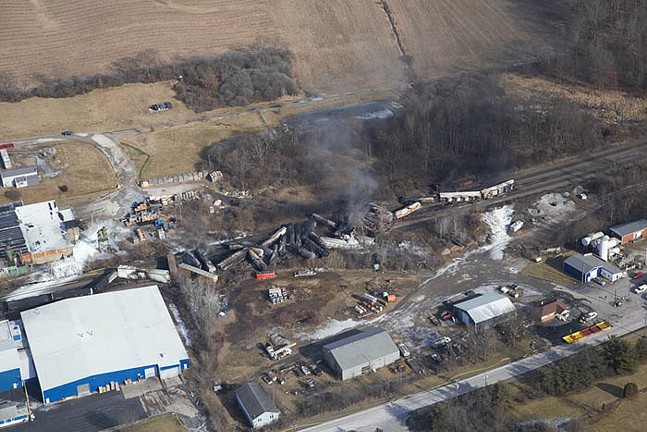The East Palestine train derailment and subsequent toxic blast has raised fears about the possible health risks posed to people living all across the region. To address these concerns, the Carnegie Science Center convened a panel of experts during a Feb. 23 virtual meeting where they discussed the impacts to local air and water, and speculated about the range of affected areas. In general, there’s some comforting news for Pittsburghers, but those living close to the crash site are still encouraged to be vigilant.
More on that below, but first, some background:
What happened?
On the evening of Feb. 3, a Norfolk Southern Railway locomotive derailed in East Palestine, Ohio, dragging 38 trucks off the tracks. Eleven of these were carrying hazardous materials, which ignited after the impact. Three days later, local and national agencies conducted a controlled “burn and vent” operation to mitigate explosion risks. The fire produced a thick cloud of hazardous emissions over the site, mandating the evacuation of those living within a one-mile radius.
What was released into the air?
The U.S. Environmental Protection Agency has been monitoring levels of at least five Volatile Organic Compounds around the site of the crash. VOCs are gasses, often produced in the manufacturing of paints, pharmaceuticals, and refrigerants. Depending on the concentration and period of exposure, they can be harmful to human health and cause environmental damage. Of these compounds, health officials have been particularly concerned about the release of vinyl chloride, a carcinogen known to cause liver damage.The derailed train was carrying 115,580 gallons of vinyl chloride, according to the National Transportation Safety Board.Experts say outdoor air contaminants will have quickly dissipated following the controlled burning process. But, they add, poorly ventilated homes and other buildings could trap VOCs inside for longer periods.
What was released into the water?
Some of those same VOCs spewed into the air will also have found their way into the local watershed. While fumes quickly dissipate in the open air, environmentalists warn that VOCs can linger for much longer in bodies of water, particularly those unexposed to sunlight.Peng Gao, an assistant professor of environmental and occupational health at the University of Pittsburgh, said during the Science Center panel that the lingering levels of water contamination are not yet clear.
“So the risk is hard to tell if we don't have the concentration level in the samples,” Gao said. “We have to do the comprehensive carcinogenic health risk assessment based on the levels, and then we can tell the residents and community how high the health risk is.”
Until more is known, James Fabisak, director of Pitt’s Center of Healthy Environments and Communities, cautions those who rely on private well water to get their supply sampled.
How far is safe?
The site of the East Palestine train derailment is approximately 40 miles northwest of Pittsburgh, raising concerns for many residents about what they may have been exposed to by the blast. The three panelists agreed the area of concern does not reach that far.“I would feel very comfortable that the Pittsburgh region itself has faced very little impact as a result of any of this,” Fabisak says.
But closer to the site, those living in towns like New Castle in Lawrence County and Monaca in Beaver County may need to take more precautions, like indoor air testing and well water sampling.
How far out does this extend from the crash? The answer is unclear.
“I think there is no magic number in terms of the distance,” Gao said. “What I can say is just if you are closer to the accident site, you’ve got a higher chance of risk to the impact.”
What are the potential health impacts?
Speaking during Thursday's panel discussion, Juliane Beier of the Pittsburgh Liver Research Center said the risks of vinyl chloride in “high concentrations over a long period” is well documented, but notes new research suggests it may be harmful in low doses over prolonged periods, raising potential concerns for those living near East Palestine.“So this is something that we will have to monitor,” Beier said.
The possible emission of combustion byproducts like dioxane, a known carcinogen and irritant, has also raised concerns for some living near the crash site. Once again, experts say, the levels of this are unclear, and depend to some extent on the effectiveness of the controlled burn.
“Right now we have really limited detail on these possible combustion byproducts,” Gao said. “So we definitely want to push agencies to monitor more of these chemicals.”
How can I protect myself and my family?
With the immediate threat of air contamination no longer at the fore, the panelists noted indoor air and water supplies might still pose health risks. Those living near the site are advised to test their indoor air and, if relying on well water, sample their water supply. Ventilating your home and thoroughly cleaning the interior could also reduce indoor health risks. Pets and children should be discouraged from playing outside in areas where ashes were seen covering the ground, the panelists added.The EPA is offering free cleaning services to impacted residents. The agency has also launched an air sampling dashboard with data collected from the crash and is operating a dedicated information hotline which can be reached at 866-361-052 between 8 a.m.-8 p.m.


